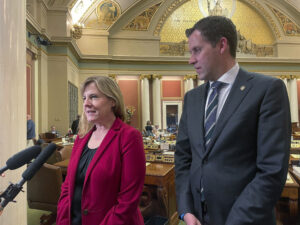Backsliding Under the Ceiling
At fancy Washington dinner parties decades ago, it was the custom for men and women to part ways after the meal.WASHINGTON — At fancy Washington dinner parties decades ago, it was the custom for men and women to part ways after the meal. The men stayed at the table for brandy, cigars and Serious Talk; the women, as Katharine Graham recounted in her autobiography, retreated “to powder their noses and gossip.”
Mrs. Graham, mercifully, put a stop to that fusty custom. Last weekend, though, I was at a Washington dinner — the old-friends kind, not the fancy variety — and the genders split on their own accord.
The men, bless their sports-addled brains, watched basketball. The women talked politics — specifically, gender politics. Our group included veterans of Geraldine Ferraro’s vice presidential campaign, so the question naturally arose: Have things turned out better or worse for women in politics than we expected back then?
Way worse, was the unanimous conclusion of our group — a hospital administrator, a civil rights lawyer, a business school professor and a recovering Senate staffer. Who would have thought, in the heady days when “It’s a Girl” cigars were being passed out on the convention floor, that 27 years later there would not have been a woman president or vice president?
Not me, although I adopted the glass-half-full attitude. Absent the phenomenon of Barack Obama, Hillary Clinton would have been president — and the arc of gender politics would have taken on a far rosier hue. In 1984, when Ferraro was tapped to be the vice presidential nominee, there were only 24 women in Congress, including two senators. Today, there are 88, including 17 senators (the most senators ever). The overt sexism that Ferraro encountered — questions about whether she could bake muffins or, alternatively, pull the nuclear trigger — is inconceivable today.
On the other hand, the number of women in Congress fell this past year, although slightly. Perhaps more alarming, according to the Center for American Women and Politics, the number of women in state legislatures, a breeding ground for national politics, dropped by 81, a full percentage point.
What has me more rattled is a new report by Princeton University about the declining number of female students serving in leadership positions there (student body president, editor of the newspaper) or winning academic prizes and prestigious post-graduate fellowships.
“We had assumed … that after the pioneering years of undergraduate coeducation at Princeton, women would have moved steadily into more and more prominence in campus leadership,” concluded the report, ordered by President Shirley Tilghman. “In fact, this was true through the 1980s and 1990s. But … there has been a pronounced drop-off in the representation of women in these prominent posts since around 2000.”
During the 1990s, for instance, 22 women served in such resume-burnishing roles. In the following decade, that number fell by nearly half, to 12 — even as the proportion of women in the class grew to nearly equal numbers. Only one woman has been elected president of the student government since 1994.
This backsliding is not a Princeton-specific phenomenon. Harvard hasn’t had a woman head of its undergraduate council since 2003. Yale has elected one woman as student body president in the last decade. Despite the stellar credentials required for admission, women arrive at Princeton, as at similar colleges, reporting lower levels of self-confidence and less likely to think of themselves as leaders than equally qualified men.
The Princeton study describes a situation familiar to anyone who’s ever sat through a meeting with both genders. Women “undersell themselves” and “make self-deprecating remarks.” Women are “more reticent about speaking up,” where men tend “to raise their hands and express their thoughts even before they are fully formulated.”
And, the explanation most persuasive and disturbing: Women don’t win these offices because women don’t run for them. They’re more likely to do the behind-the-scenes grunt work.
This finding echoes a 2008 study by Jennifer Lawless and Richard Fox concluding that “women perform as well as men when they do run for office.” The problem occurs beforehand, with “a substantial gender gap in political ambition.” The numbers of female candidates grew during the 1980s and 1990s but has since leveled off.
I can understand that women juggling work and family might be deterred from seeking the political life. But college students? Among the most accomplished college students in the country? If they’re not pushing their way to the front now, what happens after graduation?
The Ferraro aftermath notwithstanding, it’s unimaginable that, sometime in the next 27 years, there won’t be a woman elected president. Or is it?
Ruth Marcus’ e-mail address is marcusr(at symbol)washpost.com.
© 2011, Washington Post Writers Group
Your support matters…Independent journalism is under threat and overshadowed by heavily funded mainstream media.
You can help level the playing field. Become a member.
Your tax-deductible contribution keeps us digging beneath the headlines to give you thought-provoking, investigative reporting and analysis that unearths what's really happening- without compromise.
Give today to support our courageous, independent journalists.






You need to be a supporter to comment.
There are currently no responses to this article.
Be the first to respond.